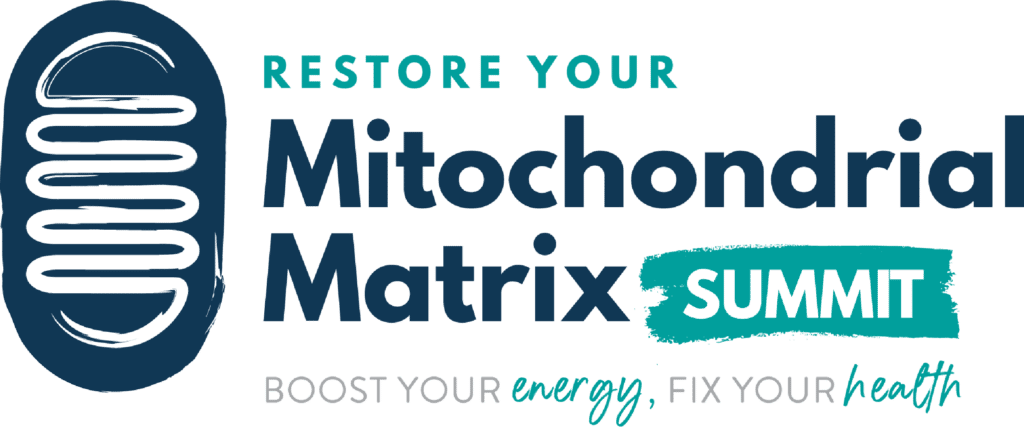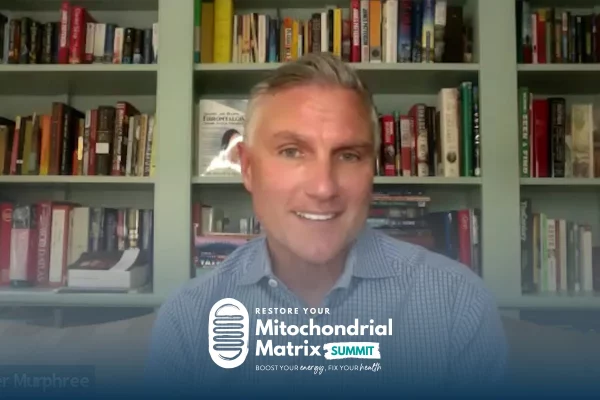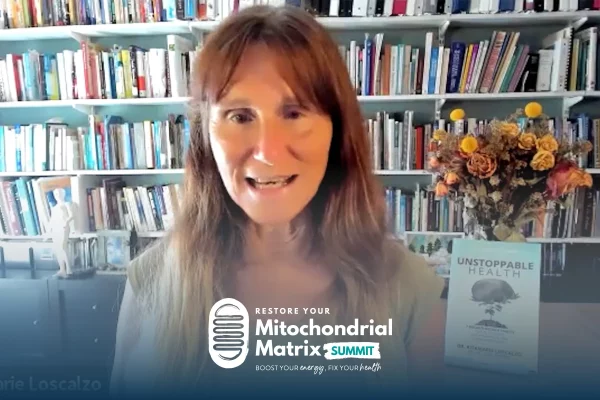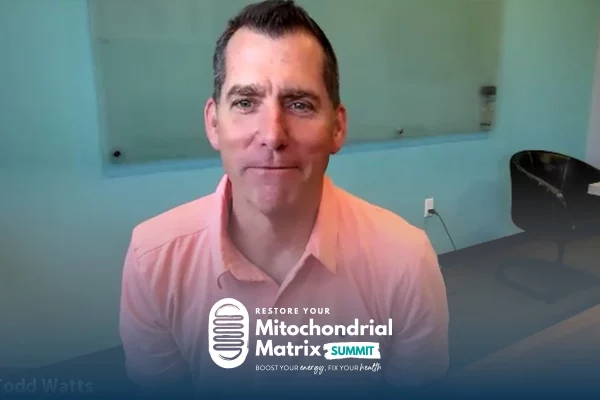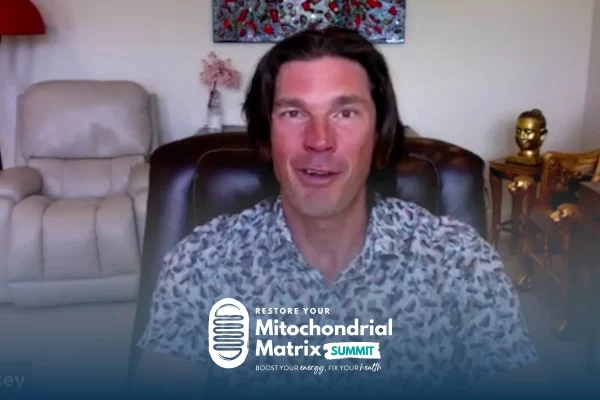Join the discussion below

Laura Frontiero, FNP-BC, has served thousands of patients as a Nurse Practitioner over the last 22 years. Her work in the health industry marries both traditional and functional medicine. Laura’s wellness programs help her high-performing clients boost energy, renew mental focus, feel great in their bodies, and be productive again.... Read More
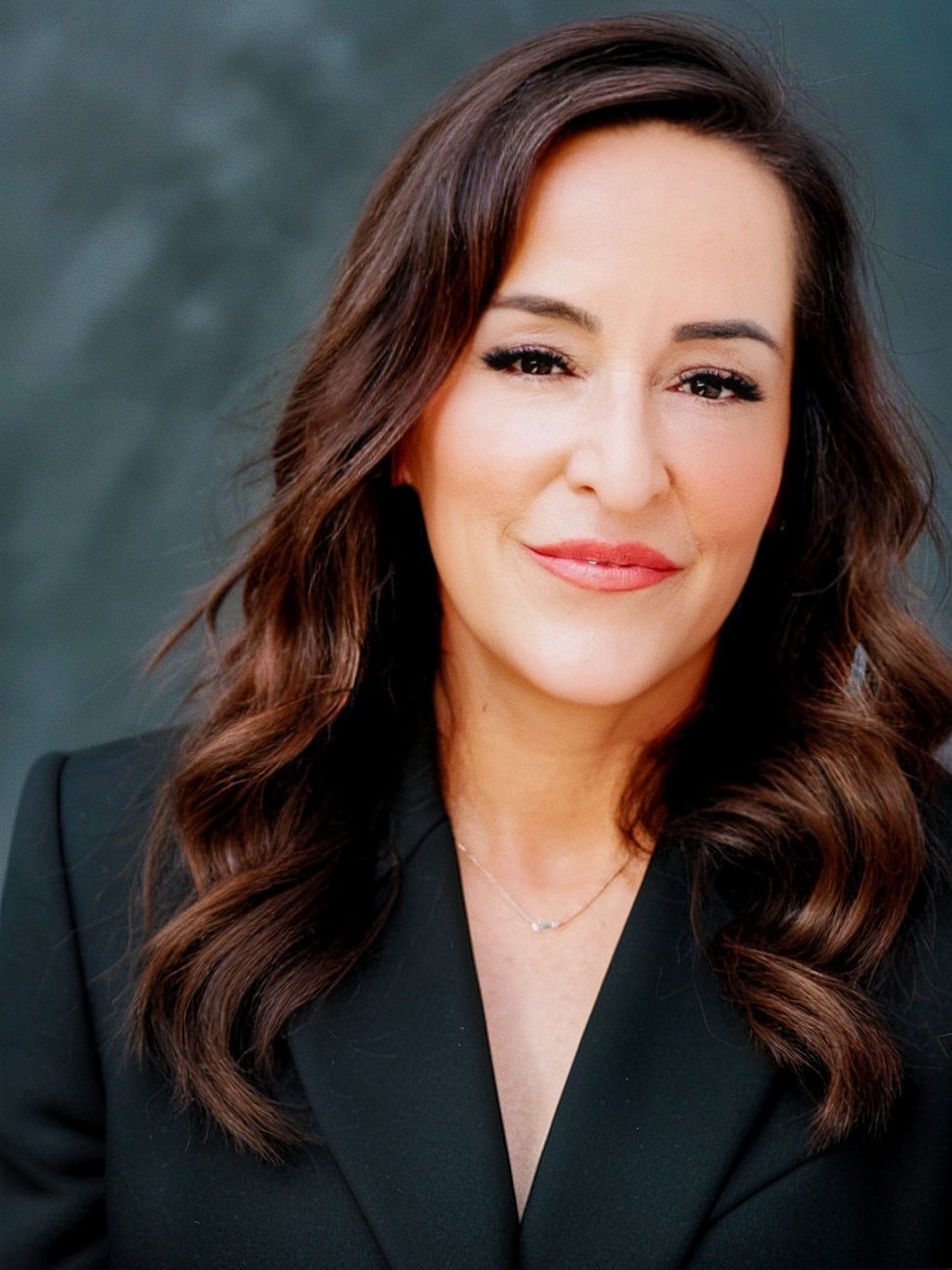
Betty Murray, PhD-Candidate, MS, CN, IFMCP
Nutrition expert, certified functional medicine practitioner, and speaker Betty Murray, PhD-Candidate, MS, CN, IFMCP helps women 40+ harness their hormones to lose weight, optimize sleep, restore energy, and thrive in life. During her research for her Ph.D., Betty made 4 key discoveries that lead to hormone imbalances that plague women... Read More
- How to reverse the effects of menopause and hormone changes so you can get your mitochondria working again.
Related Topics
Atp Production, Autoimmune Disorder, Biochemistry, Cellular Metabolism, Colitis, Digestive Problems, Energy, Estrogen, Fat Storage, Food, Functional Medicine, Genetics, Health Coaching, Hormone Imbalances, Hormones, Immune System, Insulin Sensitivity, Liver, Menopause, Metabolism, Mitochondria, Mitochondrial Health, Nutrition, Protein, Research, Sleep, Uric Acid, Weight Gain, Weight LossLaura Frontiero, FNP-BC
You’re watching the Restore your Mitochondrial Matrix Summit. I’m your host, Laura Frontiero and I’m bringing you experts with fresh ideas and proven methods to help you boost your energy and fix your health so you can build the life you love. And today my special guest is Betty Murray. Hi Betty, welcome to the summit.
Betty Murray, PhD-Candidate, MS, CN, IFMCP
Hi Laura, thank you for having me. I’m so excited to be here.
Laura Frontiero, FNP-BC
Yes, I am excited to have you too, because we are gonna talk deeply today about a lot of my favorite topics for women, estrogen, genetics, metabolism, menopause, weight loss, all of those good things. But first I wanna introduce you before we dive into those topics, now you are a nutrition expert and you’re a certified functional medicine practitioner, and you really specialize in helping women harness their hormones so they can lose weight, optimize their sleep, restore their energy and thrive in life. So this is the right audience for you.
Now, during your research for your PhD, you actually made four key discoveries that lead to hormone imbalances, and they actually plague women over 40. And by restoring balance to these key metabolic pathways, you actually help your clients lose weight with ease and get their sleep back and turn up their energy. And we can find you on your podcast, the Functional Life podcast and you’re also the founder and CEO of Living Well Dallas Functional Medicine Center and we can also catch you on TV, you’ve been on Fox, NBC, CBS. So welcome you are a wealth of knowledge and expertise. So before we jump into this topic, tell me a little bit about how you got here. How did you end up doing this?
Betty Murray, PhD-Candidate, MS, CN, IFMCP
You know, I think the beauty in functional medicine in particular, so many of us come from our own experience and our own trials and so I think it makes a better practitioner. So I actually had a different career. I was in sales and marketing and got swept into the technology boom in the early ’90s. So I was a tech geek. I was in IT and I was hired to work for the CTO of a company only female ever in that company. So I was immediately elevated into an executive sort of position, first female ever hired in that company in IT. So I worked about a hundred hours a week, spent six months of the year on the road.
And at the time I had digestive problems that would come and go, but you know, you’re in your 20s, you don’t notice it when you’re younger, you get a little bit older, like that’s not good. Well, I ended up getting diagnosed with colitis. It accelerated as my stress level got higher and higher and I remember sitting there with the doctor and asking the question, could it be something I’m eating? Could I change my diet with a digestive autoimmune disorder and make an improvement? And he literally laughed in my face and told me, food had nothing to do with it and then I needed to go on a medication. And at that moment I was like, okay, a five year old could tell me digestion has a lot to do with food and vice versa. So I started taking nutrition classes, I was always into fitness and exercise, I was, you know, I’d been a bodybuilder. And so I was like, I’m just gonna go take some classes and kind of revisit this. And when I got in there and I really started going into particularly the biochemistry that’s when I was like, this is where I need to be.
So I went back to school, needless to say, I fixed my colitis. But as I’m doing that, and I’m going back to school while I’m working full time in corporate America, carrying the same job, my hormones also started going awry. This is into my 30s so I start breaking out with acne on my chin, I start having extraordinary fatigue, can’t sleep. And so I always had this other part that I’m like, why is it as women in particular, we get the short end of the stick. Yes, we get to have a baby and bring life onto this planet but we see autoimmunity 10 to one to men. We suffer from IBS four times more than men. We’re more likely to have Alzheimer’s, Parkinson’s, all these other things. And I was like, there’s a huge component that has to do with our hormones and particularly the cyclical and seasonal changes of our life. And so that has become kind of a conduit of a lot of my research, whether it’s looking at immune system or hormones or whatever, and then of course going through menopause a couple years ago that made me look at it even more closely when I finally went through that doorway of menopause. So long story endless, that’s why I’m really here and doing what I’m doing.
Laura Frontiero, FNP-BC
Oh my gosh. And this is a theme with many people that we’re interviewing on this summit is solving your own problem first, realizing that there’s a need for this and actually falling in love with the process as you do it, and then committing the rest of your career and your life to helping others get better. Sounds like you’re one of those.
Betty Murray, PhD-Candidate, MS, CN, IFMCP
Definitely, definitely. And, you know, it’s constantly, you know, I think the beautiful part of this world and functional medicine, and I’d say everybody that’s probably listening to the summit is if you’ve got a learner’s mind, there’s always an opportunity to know and learn more and always an opportunity to kind of upgrade your body, upgrade your health, upgrade everything. So it’s like never ending for the overachiever in us. It’s a never ending opportunity to become better do better.
Laura Frontiero, FNP-BC
Oh yeah. There’s always room for more. So with that, let’s learn some more today. Now I wanna start with research that you identified during your PhD and you came across some key research that wasn’t really getting talked about, and it indicated that menopause changes slow cellular metabolism and turns on a effects, which in the cell. Can you share more about that and as it relates to energy mitochondrial health, ’cause it’s all related.
Betty Murray, PhD-Candidate, MS, CN, IFMCP
No, it’s all, it’s definitely all related. So what’s interesting is if you look at most even well meaning, well designed studies, almost always, there’s this kind of similar sort of packaging of information that comes out and it’s okay, we need to reduce carbohydrate content, right? Get your sugars down, get those things down so we can create insulin sensitivity at the cell because if you become insulin sensitive, you lower glucose, low and behold your body will burn fat. But I know over the 17 years I’ve been in practice that women would come into my office and say, you know what? I’m low carbonate. I’m eating high protein, low carb. I’m not cheating, I’m exercising five days a week doing hit and something isn’t working out here, right? So when I’m going through my research and I’m looking at it, I’m looking at, are there genetics at play? Are there receptor things that are happening at play?
And one of the first things I found is there’s a couple things that happened metabolically. So we’re gonna start kind of macro and work our way down. So as a woman goes through perimenopause and menopause, so in perimenopause, we usually have a lot more estrogen relative to progesterone. So many of us are in sort of an estrogen dominant state. So we’re driving these receptors, we’re driving more estrogen, which generally will make you more insulin resistant. Then as you head through menopause, you have this precipitous drop of estrogen. So those of us that might have made more estrogen actually gonna have more of these receptors for it. Well, what’s interesting is you start looking at it. Some of the things that happen is we see de novo lipogenesis So for everybody doesn’t know what that means, that is the building of fat cells, right? So in creation of fat, particularly in the liver.
So as we go through menopause that amplifies in women. So we have this uphill battle to some degree, particularly with the loss of estrogen with this increased activity, right? Increased packaging of triglycerides, increased activity at the cell, and we see some changes within the liver that also decrease the capacity for the liver to really metabolize fatty acids and other things. So we have that piece happening that’s at this sort of macro body level. So then if you drop down, you go, okay, what’s really happening in the cell. So you got your mitochondria and we have some switches in the mitochondria and it was some outstanding work by Dr. Rick Johnson out of, I think, University of Colorado, don’t quote me on that, looking at what mechanism works to turn on fat storage in animals that hibernate, right? So we have animals at hibernates like bears and squirrels and in all animals, we know animal gains weight or gains fat, let me re replace that, gains fat uncontrollably. That’s always in nature, a controlled process like bears gaining fat is so they can hibernate into the winter.
Well, the mechanism inside the cell is the increase of uric acid being built inside the cell, which acts as a mitochondrial break. So what it does is it actually slows mitochondrial function reduces the amount of ATP production and reduces A and PK, which are all those things that people don’t know what that means, it’s basically taking that powerhouse that was running on a Tesla level and says, okay, I’m gonna take you down to a Nissan LEAF. You’ll be efficient, right? So you’ll be efficient. You can move, but we’re gonna go ahead and down regulate all that activity. And I was like, okay, great, great. So I’m reading his research, which is absolutely brilliant, I love the man, and I’m like, okay, so uric acid inside the cell is the fat switch.
And it’s actually ancestrally almost all of us have this mutation because it’s what allowed us to go from apes during an ice age to a human. Otherwise we never would’ve made it, right? And so this is this controlled mechanism that happens in all animals that allows for fat weight gain. But if you go look at the research, low and behold, they don’t know as kind of a confounding thing when you look at it. Women in menopause have higher circulating levels of uric acid naturally, right? So-
Laura Frontiero, FNP-BC
So what I’m hearing is that whole problem of central kind of menopause weight gain, where it was easy to keep the weight off before menopause and now all of a sudden you’re fighting to keep it off, it’s actually something that’s animalistic. It’s in us. It’s something that happens and you know why, right?
Betty Murray, PhD-Candidate, MS, CN, IFMCP
Yeah. Yeah. So it’s basically, there’s a programmed receptor, we have estrogen receptor, alpha and beta just like we have adrenal receptor. So that receptor activity changes. We see a rise in uric acid naturally inside the cell, which tells the mitochondria slow down so powerhouse Tesla to Nissan LEAF, no offense to anybody who has an Nissan LEAF, but we just know it just doesn’t have the same amount of power, right? So all of a sudden the cell inside the mitochondria itself is getting a signal to slow, right? So I’ve got that message to slow. We have a reduction in ATP, so the actual production of energy itself. So all of a sudden we have those things happening. And then you’ve got the situation where if I’ve had estrogen changes and all that other stuff, and I’ve got high cortisol, which I’m sure people will be talking about on the summit and all these other things that happen in high achieving women, we’re gonna have some receptor problems on the cell itself for things like insulin and maybe our thyroid hormone.
So it’s coming from both directions. So for the woman that says, hey, you know, I’ve been working out with a trainer doing hit, eating low carb, you know, high protein, maybe I even did a ketogenic diet with high fat, moderate protein, whatever I did, but nothing’s happening, it’s probably because there’s something going on that’s not being addressed and it’s actually that mitochondrial function that is being basically altered by the loss of estrogen and the loss of this receptor signaling of estrogen inside the mitochondrial activity.
Laura Frontiero, FNP-BC
So I know right now people listening are thinking, okay, great, what the heck do I do about that? So I wanna get into genetics and a genetic analysis and all that, but real quick, can you wrap this up and put a bow on it and help our viewers know that there’s hope? So.
Betty Murray, PhD-Candidate, MS, CN, IFMCP
Yeah.
Laura Frontiero, FNP-BC
Yeah, so what do you do about it?
Betty Murray, PhD-Candidate, MS, CN, IFMCP
Right, so there’s always hope. I will tell you everybody, anybody I’ve ever worked with, there’s always hope. So the thing is, if we looked in nature, ’cause you gotta remember no animal on the planet gains fat uncontrollably other than humans and the animals we feed. So this is a mechanism that allows animals to survive in times of famine. So what we’ve done to our food, our food supply and the things that we’ve added to our foods are automatically making our uric acid levels slightly higher anyway. So for the woman in menopause, it hasn’t corrected for these dietary changes. Basically, what’s happened is you have, let’s say a 30% drop in function increase in uric acid just because you’re in menopause, that’s enough to shove you over the limit and basically take that Nissan LEAF that’s on its last like little bar of energy, right? So what things raise uric acid, okay? So the first thing that everybody thinks about is alcohol.
Alcohol and sugar, absolutely raise uric acid. Doesn’t matter what type of sugar, but high fructose corn syrup is absolutely the worst. And I know everybody knows you shouldn’t do it. And if you don’t know it today, you do need to know it today. So those foods automatically raise uric acid period, right? So too much alcohol, too much fructose and sugar. You’re highly processed, highly palatable food stuff. So all the processed foods, the cookies, the crackers, all that stuff. But here’s the kicker and here’s, I know this because I experienced this myself, ’cause I having been a bodybuilder, I’ve been on like a low carb diet my entire adulthood and I’m 52 going on 53 this year. And it was funny ’cause as I hit my late 40s I was like, this is not working. I was experiencing it, this isn’t just something I did esoterically.
I was living it. But what was funny, it was like, oh, if I had just a moment, my favorite meal, and this is gonna hit home for a lot of people, was gonna be a little bit of salami, a little bit of turkey, maybe a couple pieces of cheese, a whole bunch of cut vegetables. You know, I make sure it was keto, right? You know, it was keto and low carb but I love those foods. So guess what else raises uric acid. Your aged foods, right? So all your salami, the cheese you know, umami flavored foods, so things that have soy sauce in it. Well, here’s the thing, the other thing that happens is all of the food additives we put in food, everything from MSG to textured vegetable proteins, all of those things, not only turn off satiety in the brain and make you hungrier and make you desire more food, but they raise uric acid levels rapidly.
And yeast, right? So wine, beer. So uric acid naturally get raised inside the cell when there’s damage to the RNA. So things with yeast have really high amount of RNA in it. So it signals to the body, this is damage happening inside the cell. So the other thing it’s sneakily found in is look at all your packaged goods, even the stuff from whole foods, you know, your great bone bros and make sure it has no idolized yeast extracts, ’cause ye extracts are the same thing as MSG, just the slight chemical change. So a lot of what’s happening for women and men is we have just enough of this in our diet to raise that uric acid and then if you’re the woman that’s passing over menopause, now we’ve just shoved it a little bit higher.
Laura Frontiero, FNP-BC
And I think they’re eating all the right things.
Betty Murray, PhD-Candidate, MS, CN, IFMCP
Oh yeah. Oh yeah.
Laura Frontiero, FNP-BC
Yeah.
Betty Murray, PhD-Candidate, MS, CN, IFMCP
I was like, you know, panchayat? Come on that’s great.
Laura Frontiero, FNP-BC
All right, so now we know what not to eat. So what are you suggesting to your women who are struggling with this? What are you having them eat? Give them some ideas of what would work for helping prevent this uric acid level from going up.
Betty Murray, PhD-Candidate, MS, CN, IFMCP
Right, so if we’re looking at that, mostly it’s taking out things, but if we look at the things that can help, so vitamin C, so foods that are rich and vitamin C, everything from, you know, I’m not a huge fan of a lot of fruit, but having some citrus here and there, if you can tolerate citrus or your tomatoes, your red bell peppers, things that have high vitamin C, that can help. But if we look at the foods that are generally healthy, anyway, your leafy greens, your healthy vegetables, your animal proteins that are unprocessed and also not marinated in a bunch of food additives and things that might increase that, those things help because you get both the effect of the insulin change that’s possibly at the cell because you’ve got less glucose circulating and you have the reduction in uric acid, right? Now, the thing is the other thing that can raise uric acid a lot is a diet too high in animal protein, right? So it’s all about the dance of enough, not too much.
And I would say generally, most of my women either they’re like kind of the carnivore kind of fan. Most of them undereat animal protein. Like it’s kind of a fight to get adequate amounts. So it’s about having enough. And it’s not that you can’t do carbohydrates. I think a lot of people perceive that if I need to lose body fat, I need to take carbohydrates out. And what I found in my research and what I’ve done with the programs that I do is a lot of times we have a three phase approach. ‘Cause the first approach you have to sort of get both sides working. But in many cases, once you correct for that problem, it’s also not, I have to be on a low carb diet for the rest of my life. We actually create metabolic flexibility because that mitochondria can actually now burn both fat and carbohydrate. Because the other thing is when the mitochondria is downturn like that, it’s not gonna burn fat as its primary fuel. It’s gonna store fat.
Laura Frontiero, FNP-BC
So interesting you’re actually turning off your fat burning.
Betty Murray, PhD-Candidate, MS, CN, IFMCP
Yes.
Laura Frontiero, FNP-BC
Yeah.
Betty Murray, PhD-Candidate, MS, CN, IFMCP
Yeah, what the research shows is if your uric acid, so if you wanna get labs looked at, if it’s over 4.4, the switch is on.
Laura Frontiero, FNP-BC
So fascinating Betty. This is really, really helpful. I think people are just having light bulbs go off right now.
Betty Murray, PhD-Candidate, MS, CN, IFMCP
Oh, I thought fell out of my chair when I
Laura Frontiero, FNP-BC
Yeah. So we’ve covered really about what’s really going on with cellular metabolism here and what’s turning on the fat switch in the cell. And you’ve just, you know, schooled us all on what causes uric acid levels to go up and how I find examples of that outside in nature with animals as well. Now let’s talk a little bit about genetics and mitochondria. So genetic analysis, I mean, we see it all over the place. It’s so popular to find out what’s happening with your genes. Do you think that there’s answers in our genetics? Is it worth it for people to get this kind of testing done? What’s your thought process on this?
Betty Murray, PhD-Candidate, MS, CN, IFMCP
Yeah, you know, genetics have come a long way. So, you know, I’d say even in particularly in the last three to four years, we’ve seen probably the most applicability, what’s the word I’m looking for? Applicable changes to what we can derive out of our genes compared to what it was just a couple years ago. You know, ’cause part of it, when we look at genes, we have 22,000 ish genes and they work in combination. So they’re a map, they’re not individual genes working in isolation. And when we look at a lot of those genes, many of them overlap, right? So some of the things that we look at for overlap, so there’s several genes that are important, not only for women from an estrogen metabolism standpoint, but they also affect adrenal hormones, things like adrenaline or adrenaline, dopamine.
Well, what’s interesting is some of those mutations, one of them is Co-methyltransferase or COMT and its job is to basically help you exit estrogen and xenoestrogens, and toxins out of the body. It also helps you recycle your adrenaline and get it out the system. Well, when you start digging in the research and looking at it, women who could carry mutations in COMT have a greater likelihood of, guess what? Central adiposity, metabolic syndrome, diabetes, sleep disruption, libido problems, estrogen sensitive cancers. You know, again, I happen to carry a mutation. There’s three main genes. I carry red on every single one. So I have all of them. And so when we look at that, we go, okay, what does that mean to mitochondria?
Well, you’ve got the mitochondria in different places, right? So we’ve got mitochondria in every different cell. Well, we have estrogen receptors on our fat cells on our subcutaneous fat, the stuff that we hate, the jiggly bits, the junk in the trunk, right? The stuff that we don’t like to see. Well, as we go through menopause, those estrogen receptors tend to go, the estrogen receptors die off, but we also get a lack of stimulation to the adrenal receptors on those subcutaneous fat. So it seems like you can’t ever get it off your abdomen off your hip and thighs. Well, some of that is because we have Co-methyltransferase in there that’s affecting whether you’re recycling your epinephrine or norepinephrine quickly or not.
So for those that have changes in that COMT function where that enzyme may be either over expressing or under expressing may be experiencing some of these other things that affect the mitochondrial function of those nerve cells, their ability to navigate the fat cells and actually mobilize the fat out because we have to have epinephrine that pulls the fat out. ATA picks it up and throws it out and epinephrine’s supposed to carry it away, but we won’t be able to do that if we’ve got all of these hormonal changes that are affecting those receptors capacity to do it. You know, so that’s just one example. There’s several other ones in the detox pathways and other things that can really affect cellular metabolism. But that’s just one. But you have to look at it as a much bigger picture, it’s not just getting one or two genes and going, I have that, I’m gonna take this supplement.
Laura Frontiero, FNP-BC
Oh totally. It’s just, you know, it’s just one bit, one little piece in the huge toolbox that we use in functional medicine to help figure out what is uniquely you and what will best support you to get to your goal, with energy, with weight loss, with resolution of chronic health conditions. So what I’m hearing is you use it as a tool, but it’s not the only thing that you’re going to look at.
Betty Murray, PhD-Candidate, MS, CN, IFMCP
No, it’s just the piece of the pie ’cause the other part of it is, you know, obviously your genetics is kind of the foundation of your house. So if you’ve ever built a house, you walk up to it, you go, okay, great. I know how wide it is, I know how deep it is, I know where my plumbing is. But it doesn’t tell you if it’s modern, shaker, colonial, that’s your epigenetics. How you build that house on top of it and if you were built for a single story Texas ranch house, and you build a three story condo with a pool on top, by how you live, you’re gonna mess up your DNA, right? You’re gonna mess up your genetic expectations, and your new expression is gonna be bad, but once you know how you’re built, then it makes it much easier to modify what you’re gonna do with that house and how you’re gonna decorate it in a way that’s meaningful.
Laura Frontiero, FNP-BC
Yeah, and here’s the good news, you can redecorate it and redecorate it and change your mind and do something different.
Betty Murray, PhD-Candidate, MS, CN, IFMCP
You can blast out a wall and add to it, but you gotta know what you need to do first.
Laura Frontiero, FNP-BC
Right, because your epigenetics are moveable, changeable, repairable.
Betty Murray, PhD-Candidate, MS, CN, IFMCP
Right.
Laura Frontiero, FNP-BC
Yeah. That’s the exciting part. So let’s get into talking about other key hormones that could be causing yoyo weight gain and weight loss resistance. And what is it getting talked about, you know, in the mainstream discussion of weight regain and weight loss.
Betty Murray, PhD-Candidate, MS, CN, IFMCP
Yeah, so I alluded to a couple of them it was that kind of very simplified, oh just make insulin go down and you’ll just burn fat like the most perfect fat burner. So that one’s one of the first misconceptions. One of the second ones is that our hormones are a symphony. So our hormones are a symphony and each section has its role. So we have the adrenals of the percussion, they set the pace and they set the kind of tone, right? So if your adrenals are playing scat jazz and the rest of the orchestra thinks it needs to be playing a waltz, we’re gonna have a problem. So the orchestra is gonna start shifting, right? So we have our adrenals, we have our thyroid hormones that set metabolic rate. Well, I don’t know about you, but I know I could probably count at least 60% of the women that I see will say I swear I have hormone problems.
And I swear I have thyroid problems. I know I do, but my labs look normal. I’m like, I know you have thyroid problems and your labs still look normal. Because these hormones interact with each other. So when we’re looking at whether it’s insulin sensitivity at the cell, or it’s the ability of the thyroid hormone to actually turn that cell on, we’ve got other hormones that play. So for instance, if you’ve had elevated cortisol and cortisol can either be free and out and working, or it can be metabolized and only about 5% of your cortisol is actually free, right? So there’s very little that’s acting in that moment.
But metabolized cortisol is actually where we can see how much you’re really building and how much you’re really doing. Depending on how it’s metabolized, you could be making it into these metabolites that actually block the receptor on your cells, particularly muscle cells for the thyroid hormone. So you go look, your T3, which is the active thyroid hormone looks normal on labs. You might be taking T3, but nothing’s changing. You know, nothing’s changing and it’s because there’s other hormones at play. Your cortisol metabolites may be at play. You may have estrogen, so if you’re in perimenopause to menopause, estrogen is interacting along with those hormones. So it doesn’t matter if you’re trying to do just drop insulin or you’re just trying to work on thyroid. You can’t remove the other hormones because the symphony can’t create a epic music experience without all of them playing together.
Laura Frontiero, FNP-BC
I love how you’re talking about this like a symphony.
Betty Murray, PhD-Candidate, MS, CN, IFMCP
Yeah.
Laura Frontiero, FNP-BC
This is some complex stuff we’re talking about. And when you can break it down into these easy to remember pieces, just like, you know, building a house with your genetics, you’re working with a symphony with your hormones, what do you do to help women rebalance that symphony to get it working again, to improve cellular metabolism, to get those mitochondria on line and help women be able to lose that central weight, be able to gain energy, be able to have even energy to heal the chronic health conditions.
Betty Murray, PhD-Candidate, MS, CN, IFMCP
Yeah, and then I look at it and go, how can we leave our mark on the world? ‘Cause that’s my thing. It’s women of this season of life that could change the world. Like if we aren’t happy with what the world’s doing, we have the power because we’re actually better at lots of things to create change. No offense to any men, but women can really, if we harnessed ourself and felt better, we could get a lot done. So when we’re looking at it, so every hard charging woman always tells me, they go Betty, you know, I can do the food. I can hire a cook, I can order food to be delivered to my house and everything else but when we start getting into the lifestyle pieces, they’re kind of like, whoa, whoa, don’t tell me to cut back my work, don’t tell me to, you know, try and get more sleep. But the truth is, is we have to do some level of self care because there’s only so much you can, you know, drive that car without oil in it before it just dries up.
So you have to address that. So we look at the foundations of really good lifestyle, which is protecting our sleep and getting high quality sleep. I mean, I use an aura ring, my patients use an aura ring, we get serious about really getting mathematical and looking at that stuff. And like, let’s get some data, right? What’s really happening ’cause we may not know what’s really happening. And then the other thing obviously is we have to identify. So we need to test and find out where you’re really at because two people can show up looking similarly and have a completely different metabolic profile. Some of these things are true, but how you may need to address them might be slightly different.
You know, so I think it’s important to look at your hormones and know your DNA and, you know, look at cellular metabolites and other things to figure out what’s really going on. And then it’s usually a multi-phase approach because most people, because we kind of wanna get something done and see some movement we’ll often get on this train, like I’m gonna do this diet for X amount of weeks or days or months, right? Usually weeks. And I’ll get some modicum of change. But I look at it as this distinct thing, I’m gonna do this and then I’m gonna kind of go back to doing these other things. You know, so I have a multi facial approach. The first part is, you know, pretty hardcore because we wanna make some change and make things happen but the goal is to create metabolic flexibility over time, so we become a lifestyle, not a diet because diets don’t work. They flat out don’t because we have to fix all those other things. But we definitely have to address the lifestyle piece. You can’t, yeah, you can’t overlook that.
Laura Frontiero, FNP-BC
Yeah, so give us some other tips besides, you know, I mean, how do you handle the woman who is, you know, in charge at work and she’s in charge at home and she’s also got, you know, dreams and aspirations and maybe she’s busy in her community, what kind of lifestyle changes can she make and still be able to feel like she’s keeping all those balls in the air?
Betty Murray, PhD-Candidate, MS, CN, IFMCP
Yeah. No, it’s funny, I just did a podcast on this. So one of the things that’s come out a lot with the women I work with and myself, I mean, I work on, you work on what you need to work on, right? And you work with who you need to work with ’cause you’re still working on you, right? So I struggle with this just like anybody else but what I find often is somebody that’s the CEO ’cause like I have a nonprofit, I have a podcast just way too much. And at the end of the day, often we are still supporting others in a way we’re delegation and holding people accountable with love and affection and not bubble wrapping everybody and taking care of everything for everybody ’cause a lot of times we just sort of, we sort of circulate around somebody like a moon to a planet and make sure everybody gets taken care of. And if a little thing flies out to us every once in a while, energetically we’ll take it. So often what it means is sort of taking our power back and giving people back their crap, right? It’s not my monkey and it’s not my circus. You know, it’s really, really true because a lot of it, we just go, oh, I’ve got this backpack on my back.
So every time something happens or something useful comes up, I throw it in the backpack because I might need it. And oh, you know, my partner missed this, my kids didn’t get that, so I jump in and do their homework for them or whatever, put that in the backpack. Or, you know, somebody fails to do something at work so instead of handing it back and instructing them on how to do it and going through the pain and suffering of them trying to kind of learn it and you know you could do it better faster, we take it on and we just do it. So we have to learn how to delegate and how to take our energy back.
So we have an energy therapist in my office who’s worked with me for 17 years and she told me this and it’s extremely profound. She said, the energy in which you put out, right? So the energy, we have energy body, you know, if you’ve ever walked into a room and two people were fighting in that room right before you walked in, you didn’t hear it, but you can feel it, that’s the energy. That’s the energy transference between people. So we have this energy body. She said, Betty, the more energy you put out to take care of other people with nothing coming back to you, your physical body will expand to meet that need. Because it must ground you.
Laura Frontiero, FNP-BC
Wow.
Betty Murray, PhD-Candidate, MS, CN, IFMCP
Right? So for everybody that’s struggling with weight and I’ve spent a good decade being a nutritionist, functional medicine expert and believe me, I worked with all of them overweight, ’cause I could not get it under control and some of this was this, you know. And it was like, wait a minute, I have to pull it back. And it’s so uncomfortable for hard charging women because we’ve kind of been trained to like take on other people’s stuff, you know. So I think that’s a really big piece of it. And it’s a constant sort of regaining by giving stuff back.
Laura Frontiero, FNP-BC
That’s super profound. Say that one more time.
Betty Murray, PhD-Candidate, MS, CN, IFMCP
Yeah, so the level in which you expend your energy in love and affection and probably desire to help other people, so however much your energy goes out, so I’ll give you some good examples. Somebody calls and they need cookies for school tomorrow and you just got home, it’s eight o’clock you have a hundred things to do, you’ve got a migraine, but you still do it. Even though you want to say no, but you say yes, right? All the other things like kids’ homework, partner can’t handle this, so you take care of it. You know, employees not doing their jobs, but they’ve been there for forever so you just kind of bubble wrap them and take care of them and rearrange everything to make it happen. So the level in which your physical body or your emotional state and your emotional energy and all that energy you send out expands, your physical body will expand to meet that need to ground you.
Laura Frontiero, FNP-BC
So good. That’s just like a mic drop right there. Puff!
Betty Murray, PhD-Candidate, MS, CN, IFMCP
It’s true. It’s true and especially, you know, I’m a type A, I like getting stuff done, I’m so ambitious. And I have to constantly check myself and go, okay, I love and adore you and I wanna help you, but I’m gonna hand back your monkey ’cause I don’t want your monkey on my shoulder all weekend crapping in my hair and pulling my hair and eating my food. Not my monkey, not my circus. Take it back.
Laura Frontiero, FNP-BC
And my mom always used to say that. Not my monkey, not my circus. Yeah. I love Betty, this has been an amazing interview, thank you for just dropping all your words of wisdom on us, connecting all those complex scientific concepts with analogies and making it so understandable. And why don’t you tell us right now where our viewers can find you, what’s the best place to.
Betty Murray, PhD-Candidate, MS, CN, IFMCP
Absolutely. So the best place to find me is bettymurray.com and that’s M-U-R-R-A-Y. You can also find my podcast at this Functional Life and you can find it on all podcast hosting platforms. And for anybody that’s listening, I do have a quiz that will I think link to also that you can take.
Laura Frontiero, FNP-BC
Amazing. Yes we’ll get all Yup, we’ll all your stuff linked up. Thank you so much, it has been a pleasure having you here, Betty.
Downloads
